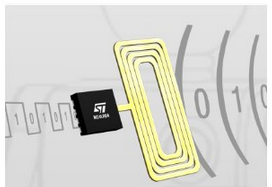
You’re likely familiar with the terms Near-Field Communication (NFC) and Radio Frequency Identification (RFID).
This article will answer a few questions you may have about RFID and NFC.
Both RFID and NFC allow you to communicate with objects via radio, to communicate with NFC you can also use the main smartphones on the market today.
Basically the NFC and RFID are born with the intention of marking objects with which you want to have a communication via radio.
Normally both NFC and RFID are battery-free and become active when they are in a magnetic field but there are also battery-powered RFIDs that extend the distance they can cover.
*** STM in its portfolio has a loot of NFC TAG & Reader.
*** General NFC/RFID presentation is here.
*** UHF reader presentation is here.
In the image below there are the radio frequencies in which they operate.
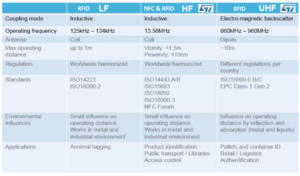
RFIDs are mainly used in the following applications:
Identification of animals, dogs, cats, cows, etc.
NFCs are mainly used in the following applications:
Payments, mobile phones, advanced identification systems, games, etc.
NFC technology is present on the most of popular smartphones, Samsung, Apple, LC, etc.
NFC, or Near-Field Communication, is a technology used to provide short-range wireless connectivity for 2-way interaction between electronic devices.
NFC uses inductive coupling between NFC devices, and operates with electromagnetic field at 13.56 MHz, a license-free allocation in the HF portion of the radio spectrum. An NFC device can draw power from the field generated by another NFC device, thus making it exempt of power supply, and to take the form of tiny objects such as tags, stickers, key remote controls or cards.
Because the transmission range is short, NFC-enabled transactions are inherently more secure than transactions based on other wireless technologies.
With little energy required to cover the interaction zone with the RF electromagnetic field, the NFC devices operate at very low power, making them ideal for battery-powered devices such as smartphones.
For more info concerning the STM NFC but also for tutorials and demo see here.
NFC forum is here.
If you need to know in deep the differences from RFID and NFC see this article.
ST25 NFC newsletter is here (May 2020)
For get the STM newsletters register yourself here.
STM’s dynamic NFC/RFID tags feature up to 64-Kbits of EEPROM memory which can be accessed either through a low-power I²C enad/or SPI interface or an RF contactless interface operating at 13.56 MHz. Both short-range:
ISO14443-A/B
ISO15693
ISO18092
FeliCa
NFC Forum protocols.
- M24SR series: ISO14443-A NFC forum type 4 dynamic tag designed for consumer electronics, wearable, home appliances and more.
- M24LR series: ISO15693 dynamic tag optimized for industrial, metering, healthcare, medical equipment and more. Capable of energy harvesting.
- ST25DV series: ISO15693 NFC forum type 5 dynamic tag suited for consumer electronics, industrial, metering, electronic shelf labels IoT objects and more.
ST25DVxx is pin to pin compatible with the M24LExx.
Ideal for industrial, consumer and IoT applications.
– - ST25TV series: NFC type 5 tags, ISO/IEC 15693, Fast operations, up to 53 kb/s speed, Tamper detection
– - ST25TA series: ISO14443-A NFC forum tag type 4. Ideal for wireless pairing (WiFi, BLE) and product identification, features counters, data protection (password), and able to wake-up the host chip thanks to a general purpose output.
– - ST25R reader series: provides multiprotocol support for 13.56 MHz NFC / RFID communications as ISO14443 Type A or B, ISO15693, ISO18092, FeliCa and NFC Forum protocols.
–
–
See this and this presentation.
– - Families
- NFC/RFID Readers
- ANTENNA DESIGN
- Presentationa & AN
- Evaluation Boards
- Tutorial
- Professional products for Testing and not only, for NFC/RFID/TAG
TAGs Families
M24LRxx
The M24LR series offers a long-range RFID interface compatible with ISO 15693 and ISO 18000-3 mode 1 compatible NFC phones.
It features an innovative energy harvesting function that enables batteryless designs.
It can be used in a wide variety of applications, including consumer electronics, computer peripherals, home appliances, industrial automation and healthcare products.
- ISO 15693 and ISO 18000-3 mode 1 compatible
- 400 kHz I²C serial interface operating from 1.8 to 5.5 V
- EEPROM memory density from 4 Kbits to 64 Kbits
- Energy harvesting
- 32-bit password protection
- RF WIP/busy output pin
- Speed operations (26,48Kb/s)
- Simple antenna design, backward compatible with M24SR series
M24SRxx
The M24SR series provides an NFC forum tag type 4 RF interface and supports the NFC data exchange format (NDEF).
This enables NFC use cases such as simple Bluetooth pairing and other connection handovers, automatic links to URLs, storage of Vcard and other types of information.
It can be used in a wide variety of applications, including consumer electronics, computer peripherals, home appliances, industrial automation and healthcare products.
- The RF protocol is compatible with ISO/IEC 14443 Type A and NFC Forum Type 4 Tag
- 1 MHz I²C serial interface operating from 2.7 to 5.5 V
- EEPROM memory density from 2 Kbits to 64 Kbits with built-in NDEF message support
- RF disable pin allowing the application to control RF access from NFC phones
- 128-bit password protection
- High speed operations (106Kb/s)
- General-purpose output pin allowing flexibility for the applications (wake up on several types of events)
- Simple antenna design, backward compatible with M24LR series
ST25xx
The ST25 tags and dynamic tags use the 13.56 MHz HF band.
They are compliant with ISO/IEC 14443A or B and ISO/IEC 15693 and NFC forum standards and offer a range of EEPROM memory sizes from 512 bits to 64-Kbits.
Some has inside 256 byte of RAM for a fast comunication.
Some models support energy harvesting.
ST25DVxx is pin to pin compatible with the M24LExx.
- 13.56MHz HF interface
- ISO14443 A/B, ISO15693 and NFC Forum compliance
- From 512bit to 64-Kbit memory
- Some has inside a 256 byte of RAM for fast comunication
- Energy Harvesting (in some version)
- I2C interface
- Up to 32-bit counter with anti-tearing
- Field detect output
- OTP bytes
SRTAG-D
The SRTAG-D series provides an NFC forum tag type 4 RF interface and supports the NFC data exchange format (NDEF). This enables NFC use cases such as simple Bluetooth pairing and other connection handovers, automatic links to URLs, storage of Vcard and other types of information. It can be used in a wide variety of applications, including consumer electronics, computer peripherals, home appliances, industrial automation and healthcare products.
- NFC forum tag type 4 based on ISO 14443 RF interface
- EEPROM memory density from 2 Kbits to 16 Kbits with built-in NDEF message support
- High-speed operation (106 Kbit/s)
- 128-bit password protection
- General-purpose output pin allowing flexibility for applications (microcontroller wake up)
- Simple antenna design, backward compatible with all dynamic NFC/RFID tag series
Go on TOP
NFC/RFID Readers
The STM dedicate page is here.
The ST25R HF reader series provides multiprotocol support for 13.56 MHz NFC / RFID communications as ISO / IEC 14443 Type A or B, ISO / IEC 15693, ISO / IEC 18092, FeliCa and NFC Forum protocols.
ST25R39xx devices provide a complete solution for payment and point of sale terminals (POS) with the ST25R3911B/12/13 boasting EMVCo & PBOC certifications while the ST25R3914/15 are full AEC-Q100 grade 1 automotive grade making them ideal for keyless entry and immobilizer applications. They are also ideal applications like access control, door locks and gaming.
The CR95HF products are suitable for a wide spectrum of applications including identification, authentication, product configuration, access control, door locks and industrial tag readers.
Now we suggest to use the ST25R3911B. The demo board is: ST25R3911B-DISCO
–
The ST25RU UHF reader series provides multiprotocol support for the 840-960 MHz UHF band compliant with ISO 18000 6c & b, ISO 29143 and UHF EPC GEN2 RAIN standards.
The ST25RU39xx devices are optimized for solutions for supply chain and logistics applications, asset tracking, cold chain management and a variety of IoT based applications.
See for example the ST25RU3993 and the relative evaboard
More info are here.
Go on TOP
ANTENNA DESIGN
eDesignSuite Simple antenna design, compatible across M24LR, M24SR and SRTAG-D series is here
…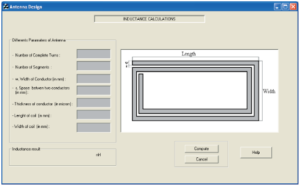

Go on TOP
Presentations & AN
- NFC/RFID – ST25 product overview – June 2017
- M24LR series
- M24SR series
- M24xR & CR95HF presentation
- Everything you need to know about NFC technology… and more, is here (TN1216).
Go on TOP
Evaluation Boards
X-NUCLEO-NFC01A1 (mount M24SR64-Y) is a Dynamic NFC tag evaluation board to allow expansion of the STM32 Nucleo boards.
It is compatible with the Arduino UNO R3 connector layout and it is designed around the M24SR64-Y.
The M24SR64-Y device is a dynamic NFC/RFID tag IC with a dual interface. It embeds a 64 Kbit EEPROM memory.
It can be operated from an I2C interface or by a 13.56 MHz RFID reader or a NFC phone.
The board is powered through the Arduino UNO R3 connectors. It also includes three LEDs for general purpose.
The SW to use is here.

.
The MATRIX-M24SR board features various antenna designs for M24SRXX-Y Dynamic NFC/RFID tag IC family combined on a single ready-to-use divisible PCB.
Each individual antenna features an M24SR64-Y Dynamic NFC/RFID tag IC connected to an RF antenna on one side, and to an I2C bus on the other side.
All antennas are populated with M24SR64-Y Dynamic NFC/RFID tag IC but are applicable to other densities.
The MATRIX-M24SR antenna matrix allows system designers to evaluate the M24SRXX-Y family performance and capabilities and to get started with their design.
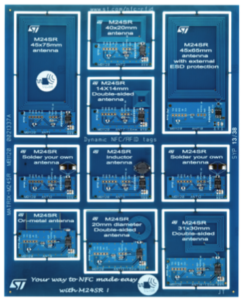
–
The M24SR-DISCOVERY is a demonstration kit to evaluate the features and capabilities of the M24SR series and is based on the M24SR64 device.
Two versions of this kit are available: the Standard Edition and the Premium Edition.
The Premium Edition includes all of the Standard edition features, plus a headset and a Bluetooth module (ver.3.0) to demonstrate the convenience to pair it with a smartphone via NFC.
The M24SR64 device is a dynamic NFC/RFID tag IC with a dual interface.
It embeds a 64 Kbits EEPROM memory. It can be operated from an I2C interface or by a 13.56 MHz RFID reader or an NFC phone.
The I2C interface uses a two-wire serial interface, consisting of a bidirectional data line and a clock line. It behaves as a slave with respect to the I2C protocol.
The RF protocol is compatible with ISO/IEC 14443 Type A and NFC Forum Type 4 Tag.
The board is powered through the USB bus. It also includes a microcontroller STM32F103 to drive the EEPROM via I2C and the LCD screen via SPI bus.
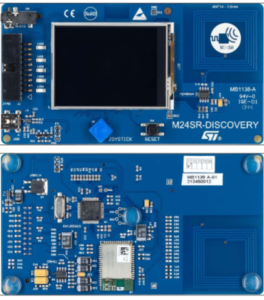
.
ST25DV-DISCOVERY, Discovery kit for ST25DV04K Dynamic NFC/RFID tag IC with fast transfer mode capability.
The ST25DV-DISCOVERY is a demonstration kit to evaluate the features and capabilities of the ST25DV series. It is based on the NFC ST25DV04K device embedded on a daughter card using a Class 1 antenna and a STM32 processor driving a mother board. A dedicated software stored in the Flash memory is provided.
The ST25DX_Discovery_Mboard is available in two versions.
The demonstration edition includes all of the standard edition features with Wi-Fi®, and BLE (Bluetooth Low Energy) modules to demonstrate various connectivity use cases. The standard edition is used to achieve the demonstration edition features (no WiFi, no BLE).
The ST25DV04K device is a dynamic NFC/RFID tag IC with a dual interface, it is pin to pin compatible with the M24LE04.
It embeds a 4 Kbits EEPROM memory. It can be operated from an I2C interface, or by a 13.56 MHz RFID reader, or by a NFC phone.
The ST25DV04K Class 1 antenna daughter card, included in the kit, can be replaced by Class 5 or Class 6 antennas. For this purpose an ST25DV antennas bundle is available for ordering.
Its references are available on the ST web site.
The ST25DV I2C interface uses a two-wire serial interface, consisting of a bidirectional data line and a clock line. The I2C two-wire serial interface behaves as a slave in the I2C protocol.
Half-duplex 256-byte (RAM) dedicated buffer.
The RF protocol is compatible with ISO/IEC 15693 and NFC Forum Type 5 tag contactless interface. The boards are powered through the USB connectors.

_
Key Features
- Expansion board based on the ST25DV04K dynamic NFC/RFID tag for STM32 Nucleo
- Up to 4-Kbit memory with NDEF support
- 54 mm diameter, single layer circular antenna
- Compatible with STM32 Nucleo boards
- Equipped with Arduino™ UNO R3 connector
- Self-powered or powered through the Arduino™ UNO R3 connectors
- Three general purpose LEDs
- Scalable solution, capable of cascading multiple boards for larger systems
- Free comprehensive development firmware library and example for ST25DV04K, compatible with STM32Cube firmware
- FCC and IC verified
- RoHS compliant

–
Key Features
- On-board NFC card reader IC: ST25R3911B
- 47 mm x 34 mm, four turns, 13.56 MHz inductive antenna etched on PCB and associated tuning circuit
- Six general purpose LEDs
- ISO 18092 (NFCIP-1) active P2P
- ISO 14443A and ISO14443B
- ISO 15693
- FeliCa™
- VHBR
- 6.8 Mbit/s AFE and PCD to PICC framing
- 3.4 Mbit/s PICC to PCD framing
- Up to 1.4 W output power with differential antenna
- Possibility of driving two antennas in single ended configuration
- Inductive and capacitive wake-up
- Automatic antenna tuning system
- Transparent and Stream modes to implement MIFARE™ Classic compliant or other custom protocols
- Equipped with Arduino™ UNO R3 connector
- Free comprehensive development firmware library compatible with STM32Cube and samples for ST25R3911B
- Scalable solution for multiple board cascade
- FCC certified
- RoHS compliant

–
The souce code is: STSW-ST25R002
Key Features
- Based on ST25R3911B high performance HF reader / NFC initiator with 1.4 W output power, supporting VHBR and AAT
- ISO 18092 (NFCIP-1) active P2P
- ISO14443A, ISO14443B and FeliCa™
- ISO15693
- Supports VHBR (3.4 Mbit/s PICC to PCD framing, 6.8 Mbit/s AFE and PCD to PICC framing)
- Up to 1.4 W output power with differential antenna
- Possibility of driving two antennas in single ended mode
- Inductive and capacitive Wake-up
- Automatic antenna tuning system
- DPO (Dynamic Power Output)
- User selectable and automatic gain control
- Transparent and Stream modes to implement MIFARE™ Classic compliant or other custom protocols
- 6 Mbit/s SPI
- Wide supply voltage range (from 2.4 V to 5.5 V)
- QFN32, 5 mm x 5 mm package
- STM32L476RET6 32-bit microcontroller with 512 kB of Flash memory
- 105 mm x 52 mm, two turns antenna etched on the PCB, and associated VHBR tuning circuit
- Micro-USB connector for communication with the host PC and board powering
- Six LEDs indicating the presence of the RF field and of the protocol used to communicate

The X-NUCLEO-NFC02A1 is a dynamic NFC/RFID tag board based on M24LR04E-R, for expansion of STM32 Nucleo boards.
The M24LR04E-R is an NFC Type V/RFID tag IC with a dual-interface 4 Kbit Electrically Erasable Programmable Read-Only Memory (EEPROM) that also features an I2C interface.
The EEPROM is organized as 512 x 8 bit in the I2C mode and as 128 x 32 bit in RF mode. It can be operated either from an external power supply or directly powered by the received carrier electromagnetic field.
The tag provides an user configurable digital output pin toggling during either RF Write in Progress or RF Busy mode.
The M24LR04E-R provides an Energy Harvesting mode. When activated, the M24LR04E-R delivers the excess energy coming from the RF field on the Vout analog pin. In case the RF field strength is insufficient or when Energy Harvesting mode is disabled, the analog output pin Vout goes into high-Z state and Energy Harvesting mode is automatically stopped.
The X-NUCLEO-NFC02A1 is compatible with the Arduino™ UNO R3 connector pin assignment and interfaces with the STM32 MCU via the I2C pins.

–
M24LR-DISCOVERY is a ready-to-use kit which features the M24LR04E-R Dual Interface EEPROM IC.
It addresses a wide range of applications such as industrial or medical equipment and consumer electronics.
This kit contains 2 different boards:
1) The M24LR board (the board with the LCD display) is battery-less and is powered by RFID readers or NFC-enabled phones supporting ISO/IEC 15693.
2) The RF transceiver board is an RFID reader demonstration board and is composed, among other parts, of a CR95HF (13.56 MHz multi-protocol contactless transceiver IC with SPI and UART serial access).
This board has to be plugged in to a PC and comes with a demonstration software.
The M24LR board also works with Android NFC phones supporting ISO/IEC 15693.
An application called NfcV-Reader is available on Google Play.
Performance may vary depending on NFC phone’s RF management.
The M24LR board mount the:
M24LR04E-RMN6T/2 Dual Interface EEPROM with I2C and ISO/IEC 15693 RF interfaces, 4 Kbits of EEPROM and password protection in SO8N package
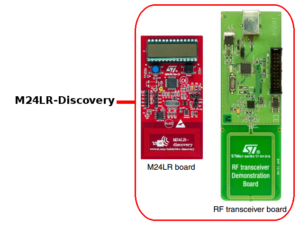
For use this kit do the steps below.
Driving the M24LR board using a smartphone
- On M24LR board the Jp1 must be present and the position is on the right (see below)

- Now enable the NFC on your smartphone and put it on the antenna of the M24LR board.
- By pressing the Blue Button on the M24LR board you change the message on the LCD display of the M24LR board.
In sequence you must see:- Copyright message
- Power supply
- Ambient temperature
Driving the M24LR board using the RF transceiver board (the green board enclosed in the kit)
- Download and install on your PC the: Windows® PC software for ISO15693, ISO14443-A/B, NFC and industrial readers
- The other steps are the same explained before, now you use the RF transceiver board for power the M24LR board
Go on TOP
Tutorial
- Training RFID Castelletto 21/05/2015
ATTENTION:
At the moment, the Training RFID Castelletto 21/05/2015 shall be issued only to SILICA customers.
- Here, there is a brief description of what you will find in the: Training RFID Castelletto 21/05/2015
Go on TOP
–
–
Professional products for Testing and not only, for NFC/RFID/TAG
- FEIG (Germany) : https://www.feig.de/en/
- MCS Test Equipments (UK) https://mcs-testequipment.com/category/rfid/
- VOYANTIC Ltd (Finland) : http://www.voyantic.com/
Go on TOP
